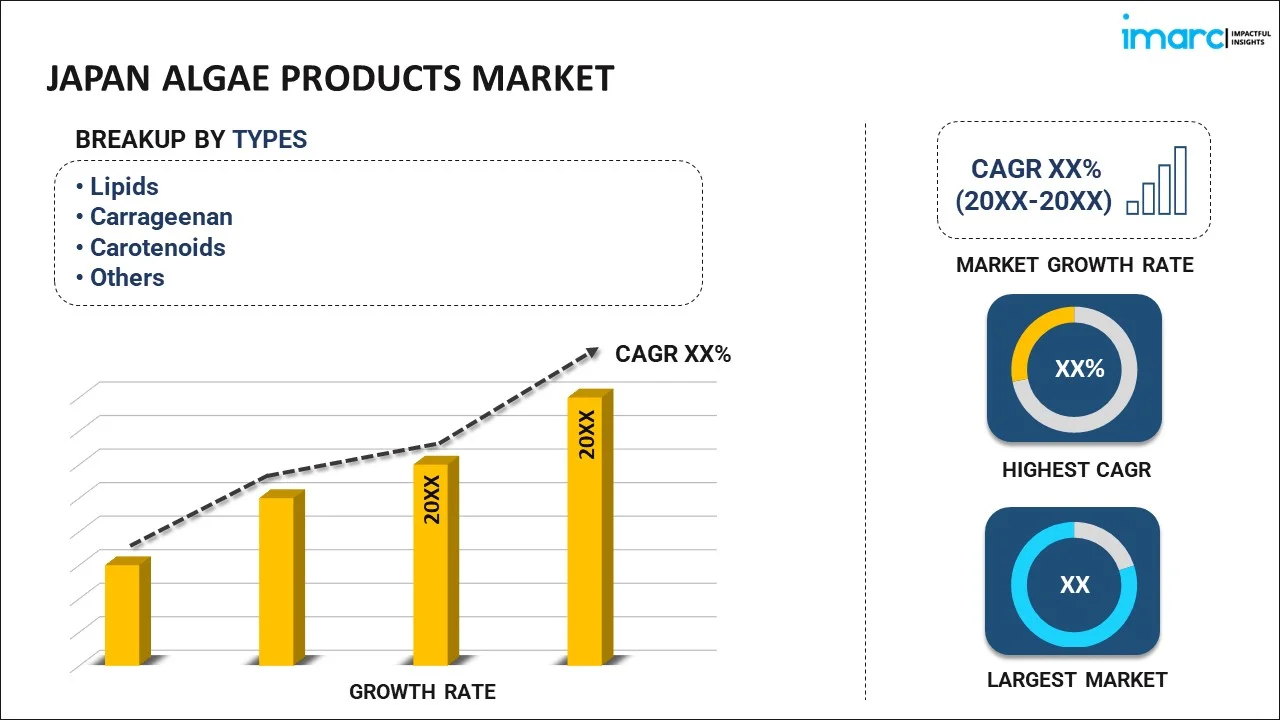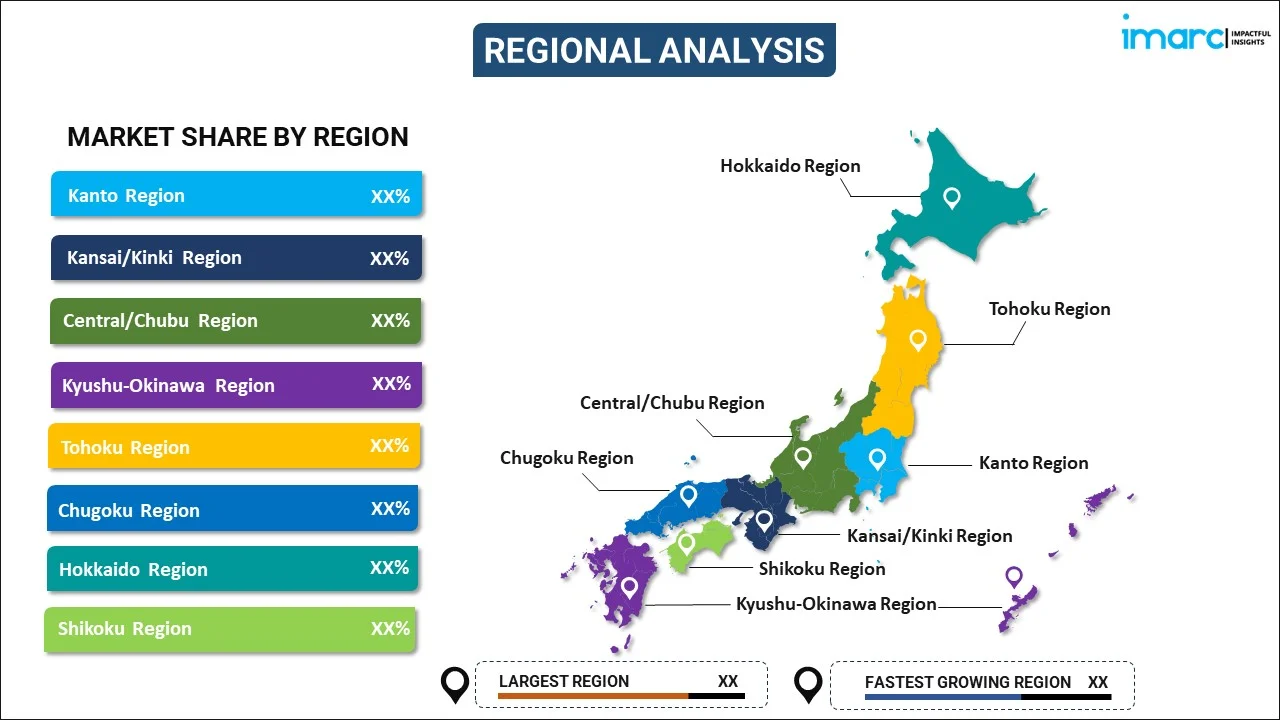
Japan Algae Products Market Report by Type (Lipids, Carrageenan, Carotenoids, Algal Protein, Alginate, and Others), Source (Brown Algae, Blue-Green Algae, Red Algae, Green Algae), Form (Solid, Liquid), Distribution Channel (Online, Offline), Application (Food and Beverages, Nutraceuticals and Dietary Supplements, Personal Care, Feed, Pharmaceuticals, Chemicals, and Others), and Region 2025-2033
Market Overview:
Japan algae products market size reached USD 120.1 Million in 2024. Looking forward, IMARC Group expects the market to reach USD 159.0 Million by 2033, exhibiting a growth rate (CAGR) of 3.2% during 2025-2033. The increasing advances in biotechnology and genetic engineering that are enabling the development of algae strains with improved characteristics, such as higher nutrient content, faster growth rates, and enhanced resistance to environmental stressors, are driving the market.
|
Report Attribute
|
Key Statistics
|
|---|---|
|
Base Year
|
2024 |
|
Forecast Years
|
2025-2033
|
|
Historical Years
|
2019-2024
|
| Market Size in 2024 | USD 120.1 Million |
| Market Forecast in 2033 | USD 159.0 Million |
| Market Growth Rate (2025-2033) | 3.2% |
Algae products refer to a diverse range of items derived from various species of algae, simple aquatic organisms that harness photosynthesis to convert sunlight into energy. These products have gained significant attention due to their versatility and eco-friendly attributes. Algae are used in numerous industries, including food, cosmetics, pharmaceuticals, and renewable energy. In the food sector, algae products are valued for their nutritional content, such as vitamins, minerals, and omega-3 fatty acids. They are used in food additives, supplements, and even plant-based meat alternatives, contributing to a sustainable and nutritious diet. Algae also play a vital role in the cosmetic industry, where they are incorporated into skincare products for their moisturizing and antioxidant properties. Additionally, algae-based biofuels are considered a promising renewable energy source, as they have the potential to reduce carbon emissions. Overall, algae products represent a promising avenue for sustainable innovation across various industries, offering solutions to environmental challenges while meeting the growing demand for eco-conscious and health-oriented products.
Japan Algae Products Market Trends:
The algae products market in Japan is experiencing robust growth, primarily driven by the escalating regional demand for sustainable and environmentally friendly products. To begin with, the increasing awareness and concern regarding climate change have propelled the adoption of algae-based products. These eco-conscious consumers are seeking alternatives to conventional resources, and algae present a promising solution. Furthermore, the rising population and expanding middle class in Japan have boosted the demand for food and dietary supplements, wherein algae-based ingredients are gaining traction due to their nutritional benefits. Consequently, this burgeoning middle-class demographic is propelling the growth of the algae products market. Additionally, government initiatives and policies promoting sustainability and renewable resources are further driving the algae products market. These regulations provide incentives and support for companies to invest in algae-based solutions, fostering market growth. Apart from this, technological innovations in algae cultivation and processing methods, which have increased production efficiency and reduced costs, making algae-derived products more accessible and affordable, are expected to drive the market in Japan during the forecast period.
Japan Algae Products Market Segmentation:
IMARC Group provides an analysis of the key trends in each segment of the market, along with forecasts at the country level for 2025-2033. Our report has categorized the market based on type, source, form, distribution channel, and application.
Type Insights:

- Lipids
- Carrageenan
- Carotenoids
- Algal Protein
- Alginate
- Others
The report has provided a detailed breakup and analysis of the market based on the type. This includes lipids, carrageenan, carotenoids, algal protein, alginate, and others.
Source Insights:
- Brown Algae
- Blue-Green Algae
- Red Algae
- Green Algae
A detailed breakup and analysis of the market based on the source have also been provided in the report. This includes brown algae, blue-green algae, red algae, and green algae.
Form Insights:
- Solid
- Liquid
The report has provided a detailed breakup and analysis of the market based on the form. This includes solid and liquid.
Distribution Channel Insights:
- Online
- Offline
A detailed breakup and analysis of the market based on the distribution channel have also been provided in the report. This includes online and offline.
Application Insights:
- Food and Beverages
- Nutraceuticals and Dietary Supplements
- Personal Care
- Feed
- Pharmaceuticals
- Chemicals
- Others
The report has provided a detailed breakup and analysis of the market based on the application. This includes food and beverages, nutraceuticals and dietary supplements, personal care, feed, pharmaceuticals, chemicals, and others.
Regional Insights:

- Kanto Region
- Kansai/Kinki Region
- Central/ Chubu Region
- Kyushu-Okinawa Region
- Tohoku Region
- Chugoku Region
- Hokkaido Region
- Shikoku Region
The report has also provided a comprehensive analysis of all the major regional markets, which include Kanto Region, Kansai/Kinki Region, Central/ Chubu Region, Kyushu-Okinawa Region, Tohoku Region, Chugoku Region, Hokkaido Region, and Shikoku Region.
Competitive Landscape:
The market research report has also provided a comprehensive analysis of the competitive landscape in the market. Competitive analysis such as market structure, key player positioning, top winning strategies, competitive dashboard, and company evaluation quadrant has been covered in the report. Also, detailed profiles of all major companies have been provided.
Japan Algae Products Market Report Coverage:
| Report Features | Details |
|---|---|
| Base Year of the Analysis | 2024 |
| Historical Period | 2019-2024 |
| Forecast Period | 2025-2033 |
| Units | Million USD |
| Scope of the Report | Exploration of Historical and Forecast Trends, Industry Catalysts and Challenges, Segment-Wise Historical and Predictive Market Assessment:
|
| Types Covered | Lipids, Carrageenan, Carotenoids, Algal Protein, Alginate, Others |
| Sources Covered | Brown Algae, Blue-Green Algae, Red Algae, Green Algae |
| Forms Covered | Solid, Liquid |
| Distribution Channels Covered | Online, Offline |
| Applications Covered | Food and Beverages, Nutraceuticals and Dietary Supplements, Personal Care, Feed, Pharmaceuticals, Chemicals, Others |
| Regions Covered | Kanto Region, Kansai/Kinki Region, Central/ Chubu Region, Kyushu-Okinawa Region, Tohoku Region, Chugoku Region, Hokkaido Region, Shikoku Region |
| Customization Scope | 10% Free Customization |
| Post-Sale Analyst Support | 10-12 Weeks |
| Delivery Format | PDF and Excel through Email (We can also provide the editable version of the report in PPT/Word format on special request) |
Key Questions Answered in This Report:
- How has the Japan algae products market performed so far and how will it perform in the coming years?
- What has been the impact of COVID-19 on the Japan algae products market?
- What is the breakup of the Japan algae products market on the basis of type?
- What is the breakup of the Japan algae products market on the basis of source?
- What is the breakup of the Japan algae products market on the basis of form?
- What is the breakup of the Japan algae products market on the basis of distribution channel?
- What is the breakup of the Japan algae products market on the basis of application?
- What are the various stages in the value chain of the Japan algae products market?
- What are the key driving factors and challenges in the Japan algae products?
- What is the structure of the Japan algae products market and who are the key players?
- What is the degree of competition in the Japan algae products market?
Key Benefits for Stakeholders:
- IMARC’s industry report offers a comprehensive quantitative analysis of various market segments, historical and current market trends, market forecasts, and dynamics of the Japan algae products market from 2019-2033.
- The research report provides the latest information on the market drivers, challenges, and opportunities in the Japan algae products market.
- Porter's five forces analysis assist stakeholders in assessing the impact of new entrants, competitive rivalry, supplier power, buyer power, and the threat of substitution. It helps stakeholders to analyze the level of competition within the Japan algae products industry and its attractiveness.
- Competitive landscape allows stakeholders to understand their competitive environment and provides an insight into the current positions of key players in the market.
Need more help?
- Speak to our experienced analysts for insights on the current market scenarios.
- Include additional segments and countries to customize the report as per your requirement.
- Gain an unparalleled competitive advantage in your domain by understanding how to utilize the report and positively impacting your operations and revenue.
- For further assistance, please connect with our analysts.
 Inquire Before Buying
Inquire Before Buying
 Speak to an Analyst
Speak to an Analyst
 Request Brochure
Request Brochure
 Request Customization
Request Customization




.webp)




.webp)












